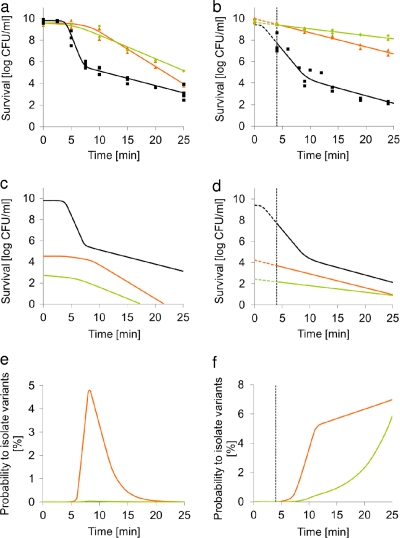Fig. 1.
(a and b) Inactivation kinetics of Listeria monocytogenes LO28 WT (black), ctsR variant number 6 (orange), and immotile variant number 17 (green) after heat treatment of exponentially growing cells at 55°C in ACES buffer (a) or HHP treatment of exponentially growing cells at 350 MPa, 20°C in ACES buffer (b). The observed values are shown as dots, and the lines represent the model-based fit. The vertical line at 4 min represents the time at which the temperature of the HHP vessel has returned to 20°C after starting the pressurization. Therefore, application of the model starts at 4 min for HHP. At t = 0 min, the measured amount of wild-type cells (N0,measured) is 9.4 log CFU/ml, whereas the extrapolated amount of wild-type cells (N0,extrapolated) is 10.3 log CFU/ml. (c and d) Predicted population inactivation of Listeria monocytogenes LO28 wild type, ctsR variant number 6, and immotile variant number 17 after heat treatment of exponentially growing cells at 55°C in ACES buffer (c) and HHP treatment of exponentially growing cells at 350 MPa, 20°C in ACES buffer (d). The number of cells at t0 of both variants is based on their estimated frequency of occurrence in the initial population. (e and f) Probability (%) of isolating resistant ctsR or immotile variants in a population of Listeria monocytogenes LO28 after heat treatment of exponentially growing cells at 55°C in ACES buffer (e) and HHP treatment of exponentially growing cells at 350 MPa, 20°C in ACES buffer (f).

